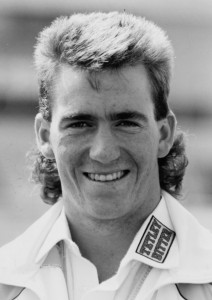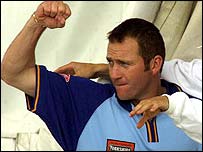
A gradual but inevitable descent into cricket-based loathing and bile.
Whatever Happened To The Unlikely Lads? #7: Craig White
We’ve written before about players who England selected in the past as part of their long quest to find the new Ian Botham – in particular Mark Ealham. As a consequence of the search (which probably started in the late 80s when Botham was injured / stoned / unpopular with the authorities and was only really concluded when Andrew Flintoff started to fulfil his potential), there are plenty of candidates to feature in this series of articles. And so we turn to a man who looked incredibly unaccomplished at the start of his international career but against all odds, became a crucial member of a resurgent team. Before going quite shit again.
The contributors to 51allout love to reminisce. Some of the time we fondly remember the stalwarts of England throughout the bad times (mostly Michael Atherton), often we discuss vividly the dregs that have been selected for a handful of caps (Mark Lathwell) and then sometimes we talk about the inbetweeners – some of whom we’ve written about already (Mark Ramprakash) – the players who were passable, but rarely achieved what they could have in the international game.
Yet our man falls somewhat outside this Venn diagram – or is it in the middle? As such, at least to this writer, he is often forgotten, offering little comedy but no genuine nostalgic value. It was to my utter embarrassment, during a late night game of sporcle, that he was one of a handful of England players since 1990 that I could not remember. So it seems appropriate to revisit his career and find out just whatever happened to…
#7: Craig White
There’s probably a very interesting thesis to be written about the relationship between global socio-economic and political changes, international migration and the make-up of the England cricket team. Condensing this opus to a paragraph, in the 1980s there was a dramatic increase in the number of players with Caribbean heritage; currently there are several born in South Africa and a few in and around the squad with Asian backgrounds. But in the 1990s, the trend was distinctly Antipodean, for example Martin McCague, Andy Caddick (we’re including New Zealand here) and the Hollioakes. Perhaps there’s direct correlation between the quality of Neighbours and the number of Australian-raised players in England.
Craig White was born in Yorkshire, but his parents brought him up in Australia. He returned to Yorkshire where he was firstly listed as an overseas player because he had to qualify to play for England. In 1994, at the age of 24, he was surprisingly picked by Ray Illingworth to play against New Zealand in the role of spare bowler and no.6 batsman. In a match that England won by an innings, White bowled just 16 overs (1/38) and scored 19. He followed up with scores of 51 and 9 at Lord’s and 42 at Manchester. Match figures of 4/54 in the third Test showed his potential with the ball and he finished the three match series averaging a respectable 30 with the bat and 32 with the ball (better than Fraser, Such, Malcolm and Taylor). Later in the summer White played the first Test against South Africa. He scored 10 and a golden duck and took two wickets, but after a thrashing by the visitors, he was dropped (for John Crawley).
Over the course of the next 30 months, White played four more Tests, in which he scored just 35 more runs and took three wickets. With averages of 15.09 and 41.09, and being overlooked in the one-day squad for such stars as Graham Lloyd and Matthew Fleming, his international career seemed over.
On 23rd May 2000, White went shopping for toiletries. But he never did get to the counter of Superdrug with a basket of shower gel, bog roll and toothpaste. To quote, taken from a Guardian interview that summer:-
“I’d just driven into Scarborough to buy a few toiletries,” he recalled. “I’d walked down the road for about 100 yards when I felt a sharp pain in my chest. I took a deep breath and a couple of strides and then I remember everything going dizzy and grey.”
“When I woke up I was lying in a gutter down a sidestreet, about 10 yards further down the road. It was raining and blood was flowing out of my chin. I was in the recovery position and a lady was ringing an ambulance. I couldn’t remember how I had got there. I must have walked the last 10 yards without even knowing.”
By the end June, he was back in the England team after spirited performances for Yorkshire and vowing to play every match as if it would be his last. (Pedants note: we’ve romanticised this story slightly; White was actually back playing limited overs cricket for England since the new year and his performances in those matches somehow had been rewarded with one of the first central contracts.) His first Test back was against the West Indies at Lord’s. His contribution was insignificant, but it didn’t matter: England dismissed the visitors for 54 and won inside two days. By this time White had grown some balls and was bowling quickly (around 90mph according to speed guns of questionable reliability) and utilising reverse swing.
It was in the 4th Test of that series that White finally showed what he could do – taking 5/57 as England claimed a 100-run first innings lead before Caddick and Gough bowled the West Indies out for 61. In the final match, he failed again with the bat (coming in at no.8 behind seven batsmen), but dismissed Brian Lara for the batsman’s first ever golden duck along his way to 5/32. In some quarters, this series victory for England was the watershed between the regular failures of the 90s and the semi-regular triumphs of the 00s, and for White it certainly presented his coming of age.
The following winter England toured Pakistan and Sri Lanka; in the former White’s reverse swing was very handy – he picked up nine wickets at 30.44 – and helped balance the attack, whilst also scoring some very useful runs (178 at 59.33 including 93 at Lahore). In the second Test in Sri Lanka, he made a composed 21* from 74 balls to see the team to victory by three wickets against Muralitharan, Jayasuriya and Vaas.
He featured in three Tests against Australia in 2001, but made three ducks and three other cheap scores; his bowling average of 189.00 was scant consolation. Nonetheless he toured India and in the second Test at Ahmedebad, almost eight years since his inauspicious debut, he made his first century: 121 in a match in which Anil Kumble took ten wickets. He finished the series averaging 41.00, but only 61.00 with the ball. The return series saw White hit a pair of 50s, including 94* from no.8 in their colossal 617ao at Trent Bridge, but then injury saw him miss out until the Ashes tour that followed. Another run of low scores was only partially offset by 4/106 and 5/127 in innings defeats at Adelaide and Perth. At Melbourne he finally made runs (85*) but he was expensive with the ball and then a rib injury led to him missing the English win at Sydney.
Although he featured in the 2003 World Cup debacle, his only telling contribution was 3/33 in the win against Pakistan. His ODI career had been as sporadic as his Test, with 51 appearances spread over more than eight years. Bizarrely, just six of those were at home, all in the 2000 series against West Indies and Zimbabwe. Only one half century tells much of the story, meanwhile his best bowling figures came at Napier (4/37) and Bulawayo (5/21).
White never played for England again; injury in 2003 prevented him getting close to international cricket, and soon after Flintoff was getting into his stride. He continued with Yorkshire, captaining them to promotion in 2005, but his career came to a fairly unheralded end in 2008, turning to a coaching role instead that has recently taken him to Hampshire.
So how to conclude?
Was he a player whose good periods were unfortunately interrupted by injury? A handy player who made important contributions to three superb series victories? Or someone whose career averages of 24.46 and 37.62 are proof that he was limited in talent and just lucky to be an ‘all-rounder’ with Yorkshire blood and Australian coaching? Probably, and somewhat appropriately, we reckon he was somewhere in the middle. At least I’ll never have the embarrassment of forgetting a man with 30 Test caps again.




3 Comments
Post a Comment
1
Matt Larnach
24 Mar 2012 00:50
More. But after 2001, less.
2
James Knight
23 Mar 2012 20:45
More or less furious than when we picked D-Patz?
3
Matt Larnach
23 Mar 2012 13:39
I remember when people in this country were furious when White was picked for England. I think they got over it pretty quickly to be honest.